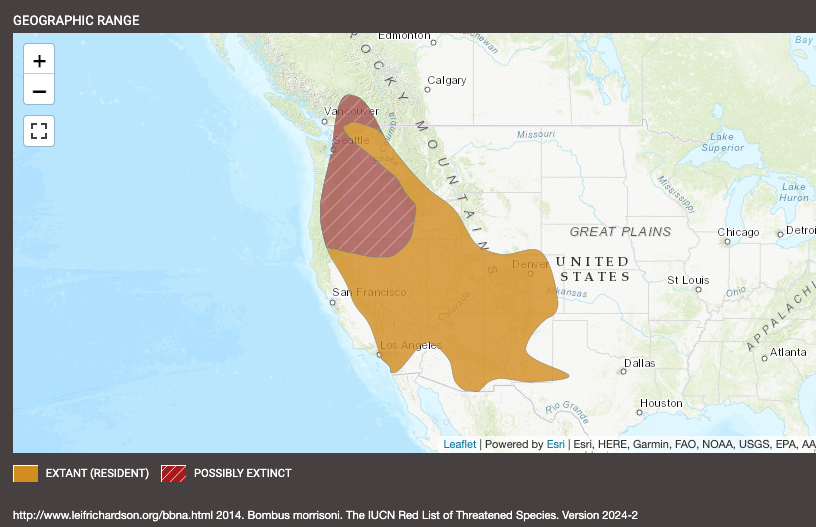The Morrison bumble bee (Bombus morrisoni) is native to western North America, occurring from California to southern British Columbia and east to New Mexico, Texas, and north to western South Dakota.

Morrison bumble bees are social bumble bees that live in colonies consisting of a queen, her offspring, and the workers. They nest underground and aboveground in structures and grass hummocks. Morrison bumble bees collect pollen and nectar from a variety of different flowering plants and are typically found in open scrub habitat, but they can also be found in other habitat types including grasslands, sagebrush steppe, and woodland edges. Some of the many kinds of plants they feed on include milkweed, milkvetch, rabbitbrush, thistles, bee plants, sunflowers, and goldenrods. They are also an important pollinator of alfalfa.
While still found broadly throughout its range, the species seems to be in decline and is considered vulnerable to extinction. Recent analysis of bumble bee occurrence records show that in the last decade, Morrison bumble bees have declined in relative abundance by 74%, and persist in 66% less area within their range than they did historically. The Morrison bumble bee was petitioned to be listed under the federal Endangered Species Act in 2023. An endangered listing would protect this species from activities that could cause it to go extinct and will allow for additional conservation measures to protect the species across its range. On January 21, 2025, the U.S. Fish and Wildlife Service initiated a status review of the Morrison bumble bee and will provide an update in a 12-month petition finding based on the status review, which will address whether or not the petitioned actions are warranted, in accordance with the Endangered Species Act. Without federal protection, this species may continue to decline to the point of extinction.
But you can help now! This bee has been documented in Los Alamos County and the early emerging queens will always benefit from more nectar to feed their growing babies and to increase their colony size.
Here are a few things you can do to support the Morrison Bumble Bee:
- Plant a variety of plants (preferably native) with diverse bloom times, varied flower shapes, and mixed coloration. Los Alamos Bee City has a list of recommended plant species for our area at https://peecnature.org/bee-city-2/color-photo-guide-to-recommended-native-plant-list/.
- Provide shallow water dishes with rocks for bees to drink.
- Preserve undisturbed wild areas in your yard.
- Be mindful of pesticide use.
- Be smart about garden clean up: don’t cut down dead plant stems too early, prune with care, don’t mulch too early.

References:
Department of the Interior Fish and Wildlife Service. 2025. Endangered and Threatened Wildlife and Plants; 90-Day Findings for Eight Species. https://www.federalregister.gov/documents/2025/01/21/2025-01118/endangered-and-threatened-wildlife-and-plants-90-day-findings-for-eight-species
Killingsworth, S., E. May, R. Hatfield, and S. Jepsen. 2023. Petition to list Morrison bumble bee as an Endangered Species under the US Endangered species Act. https://www.xerces.org/sites/default/files/publications/23-026_01_Xerces_Bombus-morrisoni-ESA-Petition.pdf
Richardson, L. L. 2022. Bumble bees of North America occurrence records database. https://www.leifrichardson.org/bbna.html. Data accessed 07-15-2022.
Text by Jenna Staneck
